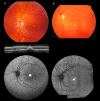RPE65 Variant p.(E519K) Causes a Novel Dominant Adult-Onset Maculopathy in 83 Affected Individuals
- PMID: 40985799
- PMCID: PMC12468096
- DOI: 10.1167/iovs.66.12.53
RPE65 Variant p.(E519K) Causes a Novel Dominant Adult-Onset Maculopathy in 83 Affected Individuals
Abstract
Purpose: Recessive RPE65-associated retinopathy is a well-known target for gene therapy, whereas dominant RPE65-associated retinopathy, due to the Irish founder variant p.(D477G), has been reported only once until now and is very rare. Here, we present the discovery of a novel, second dominant RPE65-associated retinopathy caused by variant c.1555G>A, p.(E519K).
Methods: Genomic data was investigated in a Belgian discovery cohort (n = 2873) and an international replication cohort (n = 18,796) with inherited retinal disease (IRD). Heterozygous p.(E519K) individuals underwent extensive phenotyping. Haplotype phasing was based on long-read sequencing and microsatellite analysis. Variant p.(E519K) was assessed in vitro using an enzymatic assay, Western blotting, co-immunoprecipitation, cellular thermal shift assay (CETSA), minigene assays, and in silico using protein modeling (AlphaFold).
Results: The monoallelic p.(E519K) variant was found in 83 affected individuals from Belgium, the Netherlands, France, and Canada, all of European ancestry. A shared region of 464 kilobases (kb) confirmed a founder effect. Variant p.(E519K) lowers RPE65 protein expression and enzymatic activity, with altered protein stability predicted and experimentally confirmed. Genotype-phenotype data support dominant inheritance and phenotypic variability, respectively, characterized by late-onset macular dystrophy with two main subtypes.
Conclusions: The discovery of a dominant RPE65-IRD due to founder variant p.(E519K) reduces the diagnostic gap in dominant IRD and highlights a novel target for therapy.
Conflict of interest statement
Disclosure:
Figures






Update of
-
RPE65 variant p.(E519K) causes a novel dominant adult-onset maculopathy in 83 affected individuals.Res Sq [Preprint]. 2025 May 5:rs.3.rs-5849564. doi: 10.21203/rs.3.rs-5849564/v2. Res Sq. 2025. Update in: Invest Ophthalmol Vis Sci. 2025 Sep 2;66(12):53. doi: 10.1167/iovs.66.12.53. PMID: 40386434 Free PMC article. Updated. Preprint.
References
-
- Bourne RRA, Steinmetz JD, Saylan M, et al.. Causes of blindness and vision impairment in 2020 and trends over 30 years, and prevalence of avoidable blindness in relation to VISION 2020: The Right to Sight: an analysis for the Global Burden of Disease Study. Lancet Glob Health. 2021; 9(2): e144–e160. - PMC - PubMed
-
- Redmond. TM, Yu S, Lee E, et al.. Rpe65 is necessary for production of 11-cis-vitamin A in the retinal visual cycle. Nat Genet. 1998; 20(4): 344–351. - PubMed
MeSH terms
Substances
LinkOut - more resources
Full Text Sources
Medical
Miscellaneous

